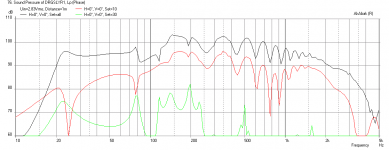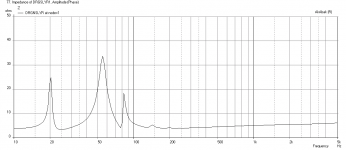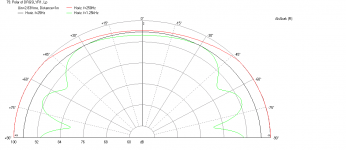A comment or two on the sensitivity of the Legend BP102 driver from Eminence. Eminence specs the sensitivity of the BP102 at 92 dB and nominal impedance of 8 ohms. Tekton specs for the Pendragon is 98 dB at 8 ohms for two drivers. Question is:
How are the two woofers connected?
Two normal BP102 drivers connected in parallel would yield a 4 ohms impedance and 98 dB sensitivity. Two of these drivers connected in series would have a sensitivity of 92 dB but an impedance of 16 ohms.
The only way the Pendragon would have an impedance of 8 ohms with these drivers is perhaps Tekton has Eminence supply them drivers with an 16 ohms nominal impedance. Then two parallel connected drivers would be 98 dB sensitivity at 8 ohms impedance would make sense.
Does anyone have an answer for this?
Jim
How are the two woofers connected?
Two normal BP102 drivers connected in parallel would yield a 4 ohms impedance and 98 dB sensitivity. Two of these drivers connected in series would have a sensitivity of 92 dB but an impedance of 16 ohms.
The only way the Pendragon would have an impedance of 8 ohms with these drivers is perhaps Tekton has Eminence supply them drivers with an 16 ohms nominal impedance. Then two parallel connected drivers would be 98 dB sensitivity at 8 ohms impedance would make sense.
Does anyone have an answer for this?
Jim
Last edited:
That's why I asked as Mike's measurements show very low levels given the test levels, often the case with pro audio drivers.
Please describe how you are interpreting the graph - in the bandwidth between 140 Hz and 800 Hz.
The only way the Pendragon would have an impedance of 8 ohms with these drivers is perhaps Tekton has Eminence supply them drivers with an 16 ohms nominal impedance. Then two parallel connected drivers would be 98 dB sensitivity at 8 ohms impedance would make sense.
Jim
No, that sounds about right.. (minus a bit of loss with the 16 ohm coils).
This would also make them "custom drivers" - which anyone can get in a lot of 50 or more from Eminence. (..and I'm guessing unit pricing would be less than 50 per driver).
Last edited:
Here is Zaph's measurement of the SB tweeter:
http://www.zaphaudio.com/temp/SBAcoustics_SB29RDCN-C000-4-HD.gif
http://www.zaphaudio.com/temp/SBAcoustics_SB29RDCN-C000-4-FR-0-15-30-offaxis.gif
http://www.zaphaudio.com/temp/SBAcoustics_SB29RDCN-C000-4-IMP-2.gif
http://www.zaphaudio.com/temp/SBAcoustics_SB29RDCN-C000-4-CSD.gif
http://www.zaphaudio.com/temp/SBAcoustics_SB29RDCN-C000-4-HD.gif
http://www.zaphaudio.com/temp/SBAcoustics_SB29RDCN-C000-4-FR-0-15-30-offaxis.gif
http://www.zaphaudio.com/temp/SBAcoustics_SB29RDCN-C000-4-IMP-2.gif
http://www.zaphaudio.com/temp/SBAcoustics_SB29RDCN-C000-4-CSD.gif
A comment or two on the sensitivity of the Legend BP102 driver from Eminence. Eminence specs the sensitivity of the BP102 at 92 dB and nominal impedance of 8 ohms. Tekton specs for the Pendragon is 98 dB at 8 ohms for two drivers. Question is:
How are the two woofers connected?
Two normal BP102 drivers connected in parallel would yield a 4 ohms impedance and 98 dB sensitivity. Two of these drivers connected in series would have a sensitivity of 92 dB but an impedance of 16 ohms.
The only way the Pendragon would have an impedance of 8 ohms with these drivers is perhaps Tekton has Eminence supply them drivers with an 16 ohms nominal impedance. Then two parallel connected drivers would be 98 dB sensitivity at 8 ohms impedance would make sense.
Does anyone have an answer for this?
Jim
I seem to recall hearing somewhere in an earlier post that Tekton is using the 4 ohm version of the BP102's and putting them in series. How do they connect the three 4 ohm nominal tweeters to get 8 ohms? If you are good with 4 ohms total then use 8 ohm central tweeter and parallel that with the two 4 ohm end ones in series. Or maybe the tweeters really are running in series as 12 ohms (close enough to 8)?
I personally like the idea of building the 'Dragon Slayer as a 4 ohm speaker to use with lower voltage (19 volt brick) class D amps to get max power. Tube amp owners may want the 8 ohm version...
xrk971 said:
"I seem to recall hearing somewhere in an earlier post that Tekton is using the 4 ohm version of the BP102's and putting them in series."
Then you have an impedance of 8 ohms but the sensitivity of the pair remains at 92 dB. No 98 dB sensitivity!
Jim
"I seem to recall hearing somewhere in an earlier post that Tekton is using the 4 ohm version of the BP102's and putting them in series."
Then you have an impedance of 8 ohms but the sensitivity of the pair remains at 92 dB. No 98 dB sensitivity!
Jim
xrk971 said:
"I seem to recall hearing somewhere in an earlier post that Tekton is using the 4 ohm version of the BP102's and putting them in series."
Then you have an impedance of 8 ohms but the sensitivity of the pair remains at 92 dB. No 98 dB sensitivity!
Jim
Right, forgot about the increase in impedance doesn't gain sensitivity. But 2 drivers in parallel is only +3dB or 95 not 98dB.
Last edited:
from the review
An externally hosted image should be here but it was not working when we last tested it.
Perhaps they think the efficiency includes the voltage gain for dropping to 4Ω eg 6dB overall gainRight, forgot about the increase in impedance doesn't gain sensitivity. But 2 drivers in parallel is only +3dB or 95 not 98dB.
Seen that before 🙄
How about 4x 8" silver flutes with 3 sb tweeters 😀
http://www.diyaudio.com/forums/multi-way/236479-8-woofer-mtm-trainwreck-7.html#post3595061
http://www.diyaudio.com/forums/multi-way/236479-8-woofer-mtm-trainwreck-7.html#post3595061
Presenting The 'Dragon Slayer
I have a design that utilizes dual Beta 10CX's in a cabinet that is a bit out of the box in aspect ratio so it won't resemble the slender tower of the Pendragon. However, I think the predicted performance is quite remarkable. Let me know what you guys think of this performance and I will reveal details of the speaker cabinet later. The design is 60 in tall x 20 in wide.
The first plot is the frequency response with the baffle placed 4 feet from a back wall with the mic at 1 meter away and with a 2.83 volt input. Notice the deep bass extension to 20 Hz (90 dB) and an average of 95 to 98 dB up through the range to the X-over point of about 1250 Hz. Although this can easily be crossed at 2500 Hz as recommended by Eminence for the Beta 10CX.
The second plot is the electrical impedance of the drivers. If you know this characteristic triple peaks, you will know what type of alignment this is.
The third plot is the driver cone excursion for both drivers, it is small and well controlled at lower frequencies.
The fourth plot is the impulse response which shows a clean secondary pulse at under 8 ms which will means that there is minimal audible group delay.
The fifth plot shows the polar directivity of this speaker for 25 Hz, 250 Hz, and 1250 Hz which is very wide angle at the upper end of the X-over to the tweeter at 1250 Hz. The sweet spot is almost 90 deg wide and lobe-free.
I have a design that utilizes dual Beta 10CX's in a cabinet that is a bit out of the box in aspect ratio so it won't resemble the slender tower of the Pendragon. However, I think the predicted performance is quite remarkable. Let me know what you guys think of this performance and I will reveal details of the speaker cabinet later. The design is 60 in tall x 20 in wide.
The first plot is the frequency response with the baffle placed 4 feet from a back wall with the mic at 1 meter away and with a 2.83 volt input. Notice the deep bass extension to 20 Hz (90 dB) and an average of 95 to 98 dB up through the range to the X-over point of about 1250 Hz. Although this can easily be crossed at 2500 Hz as recommended by Eminence for the Beta 10CX.
The second plot is the electrical impedance of the drivers. If you know this characteristic triple peaks, you will know what type of alignment this is.
The third plot is the driver cone excursion for both drivers, it is small and well controlled at lower frequencies.
The fourth plot is the impulse response which shows a clean secondary pulse at under 8 ms which will means that there is minimal audible group delay.
The fifth plot shows the polar directivity of this speaker for 25 Hz, 250 Hz, and 1250 Hz which is very wide angle at the upper end of the X-over to the tweeter at 1250 Hz. The sweet spot is almost 90 deg wide and lobe-free.
Attachments
Last edited:
I'm late to the party on this one but let me comment on what is wrong with the original Pendragon design. The configuration is essentially a MTM (actually a MTTTM in this case) with the 10" diameter driver as the Ms. So all of the issues of a wide spaced MTM show up in spades.
You can read a companion thread on a MTM with an 8" diameter M driver at:
http://www.diyaudio.com/forums/multi-way/236479-8-woofer-mtm-trainwreck.html
Wide spacing of the Ms created potential issues when you listen off axis and the Pendragon would suffer in this respect. A 10" diameter driver as the Ms is more of any issue vs. the 8" ones in the companion thread.
A better answer is to add true mids to the mix and have a WMTMW configuration. The Ws would be the 10'" diameter driver in this case but the 3-way crossover configuration becomes a more coherent performer than the original arrangement. So I'm thinking perhaps a 5-7" diameter mid (two 91-92 dB sensitivity drivers paralleled to 97-98 dB sensitivity) and a single tweeter (perhaps a ribbon for sensitivity). Now that is a speaker that would catch my attention.
Jim
You can read a companion thread on a MTM with an 8" diameter M driver at:
http://www.diyaudio.com/forums/multi-way/236479-8-woofer-mtm-trainwreck.html
Wide spacing of the Ms created potential issues when you listen off axis and the Pendragon would suffer in this respect. A 10" diameter driver as the Ms is more of any issue vs. the 8" ones in the companion thread.
A better answer is to add true mids to the mix and have a WMTMW configuration. The Ws would be the 10'" diameter driver in this case but the 3-way crossover configuration becomes a more coherent performer than the original arrangement. So I'm thinking perhaps a 5-7" diameter mid (two 91-92 dB sensitivity drivers paralleled to 97-98 dB sensitivity) and a single tweeter (perhaps a ribbon for sensitivity). Now that is a speaker that would catch my attention.
Jim
Last edited:
Have a couple of other ideas about waveguiding them together, but that's nuts, they just shouldn't be expected to lift up anything at 1.6k without serious distortion IMHO. Better match would be some 2- 3"ers with an efficiency of 93, good luck with finding that, alone done well.
Uh, oh. Greebster quoting Greebster.
I thought that was just graaf's affliction? Is it contagious?
I thought that was just graaf's affliction? Is it contagious?
I'm late to the party on this one but let me comment on what is wrong with the original Pendragon design. The configuration is essentially a MTM (actually a MTTTM in this case) with the 10" diameter driver as the Ms. So all of the issues of a wide spaced MTM show up in spades.
You can read a companion thread on a MTM with an 8" diameter M driver at:
http://www.diyaudio.com/forums/multi-way/236479-8-woofer-mtm-trainwreck.html
Wide spacing of the Ms created potential issues when you listen off axis and the Pendragon would suffer in this respect. A 10" diameter driver as the Ms is more of any issue vs. the 8" ones in the companion thread.
A better answer is to add true mids to the mix and have a WMTMW configuration. The Ws would be the 10'" diameter driver in this case but the 3-way crossover configuration becomes a more coherent performer than the original arrangement. So I'm thinking perhaps a 5-7" diameter mid (two 91-92 dB sensitivity drivers paralleled to 97-98 dB sensitivity) and a single tweeter (perhaps a ribbon for sensitivity). Now that is a speaker that would catch my attention.
Jim
The 10" or even a 12" MTM could work as long as the right tweeter is used
Creative Sound - Product Details
That tweeter can handle a 1khz xover. A MTM with drivers having a 12" OD would need to be under 1220hz, 10" OD drivers would need to be under 1350hz.
If you are thinking of difficult in finding drivers that have sensitivities in the low 90's dB or above, realize that paralleling gives you 6 dB boost assuming you also go from say 8 ohms for each driver to 4 ohms in the array. Pro sound 6 inch diameter drivers with low 90's and even mid 90's sensitivities are readily available from all manufacturers in that marketplace. Closed back mids in several diameters promise even higher sensitivities. Now 3 or 4" diameter drivers in the low 90's are relative rare but perhaps small waveguides can help.
One of my daily listening speakers have an open back MTM with PHL Audio 1240 mids (92 dB sensitivity at 16 ohms for an 98dB array at 8 ohms) and an Aurum Cantus ribbon driver with upper 90's dB sensitivity. Those numbers are direct radiators without any waveguides or horny stuff.
Jim
One of my daily listening speakers have an open back MTM with PHL Audio 1240 mids (92 dB sensitivity at 16 ohms for an 98dB array at 8 ohms) and an Aurum Cantus ribbon driver with upper 90's dB sensitivity. Those numbers are direct radiators without any waveguides or horny stuff.
Jim
The CSS planar might be too large for a MTM with 10" diameter drivers but Audio Elite suggested early in this thread that the TP150H is a possibility. Expensive but can be crossed over relatively low. My point is that sensitivity can be attained to make a speaker with 95-100 dB sensitivity bottom to top and it is easier if you have a 3-way configuration.
Jim, I already worked out the CTC distances, which is where the x-over frequencies I posted came from based on close spacing with the given OD.
The CSS tweeter is only about an inch taller then the triple SB29 tweeters, so they are good as far as CTC goes as long as Tekton is crossing close to 1khz, which it looks like based on the distortion measurements.
I dont see why any design that doesn't at least attempt to mimic several of the Pen's design decisions should be considered for this specific thread.
The CSS tweeter is only about an inch taller then the triple SB29 tweeters, so they are good as far as CTC goes as long as Tekton is crossing close to 1khz, which it looks like based on the distortion measurements.
I dont see why any design that doesn't at least attempt to mimic several of the Pen's design decisions should be considered for this specific thread.
- Status
- Not open for further replies.
- Home
- Loudspeakers
- Multi-Way
- Slay the (pen)Dragon?




